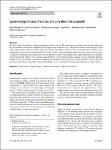Thông tin tài liệu
Thông tin siêu dữ liệu biểu ghi
| Trường DC | Giá trị | Ngôn ngữ |
|---|---|---|
| dc.contributor.author | Olivia, Boeddrich | - |
| dc.contributor.author | Anna Lena, Sander | - |
| dc.contributor.author | Thomas, Lustenberger | - |
| dc.date.accessioned | 2023-03-29T01:21:51Z | - |
| dc.date.available | 2023-03-29T01:21:51Z | - |
| dc.date.issued | 2023 | - |
| dc.identifier.uri | https://link.springer.com/article/10.1007/s00068-022-02213-5 | - |
| dc.identifier.uri | https://dlib.phenikaa-uni.edu.vn/handle/PNK/7242 | - |
| dc.description | CC BY | vi |
| dc.description.abstract | Because of their low incidence, studies about carpal fractures are rare. The aim of the present study was to analyze epidemiology and treatment of fractured carpal bones. We retrospectively analyzed data of 178 patients admitted to our emergency room with carpal fractures over 6 years. More males than woman were injured. In 91%, a CT scan was performed. The most commonly affected bone was the triquetrum followed by the scaphoid. Almost all triquetral fractures were treated conservatively as opposed to perilunate dislocations that were all operated on. Half of all patients with scaphoid fractures were operated. Young men had the highest risk to sustain a carpal fracture. | vi |
| dc.language.iso | en | vi |
| dc.publisher | Springer | vi |
| dc.subject | Epidemiology | vi |
| dc.subject | fractures comprise | vi |
| dc.title | Epidemiology of carpal fractures: is it only about the scaphoid? | vi |
| dc.type | Book | vi |
| Bộ sưu tập | ||
| OER- Y học- Điều dưỡng | ||
Danh sách tệp tin đính kèm:

